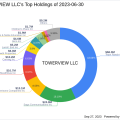- The US Dollar traded soft against its rivals on Monday after gaining more than 1% at the end of last week.
- The US will report September’s Retail Sales figures and the Fed’s Beige book.
- The rising Treasury yield and the escalation of the conflict between Israel and Palestine may limit the downside potential.
The US Dollar (USD) measured by the US Dollar DXY Index trades with nearly 0.40% losses on Monday as investors seem to be taking profits from last week’s gains, which saw the green currency gaining over 1% against its rivals. The US reported low-tier economic activity figures that failed to significantly impact the USD with the Empire State Manufacturing Survey conducted by the Federal Reserve Bank of New York declining but lower than expected. Investor’s focus is on Tuesday’s Retail Sales figures from the US and the Federal Reserve (Fed) Beige book report.
In the United States economic activity shows signs of resilience, and inflation figures revealed that the Consumer Price Index (CPI) slightly accelerated in September. This outlook favors the case of the Fed hiking at least one more time in this year, which is reflected by rising US Treasury yields. Investors seem to be gearing up for an additional 25 basis point hike by year’s end.
Daily Digest Market Movers: US Dollar consolidates last week’s gains, focus on economic activity reports
- The US Dollar DXY retreated to 106.25 after rising to 106.80 last Friday.
- The NY Empire State Manufacturing Survey from October came in at -4.6 vs the -7 expected.
- US retail Sales are expected to come in at 0.3% MoM, decelerating from 0.6%.
- US yields continue rising, with the 2, 5 and 10-year rates rising to 5.08% and 4.70%, respectively, with more than 0.50% gains.
- Evidence of strong economic activity may reignite bullish momentum for the USD following last week’s inflation figures, which saw the Consumer and Producer Price Indexes accelerating in September.
- The US reported that the Consumer Price Index (CPI) from the US came in at 3.7% YoY, which was higher than the market consensus of 3.6% and matched the previous monthly figure of 3.7% YoY. On the other hand, the Core measure came in at 4.1% YoY, matching the expectations and decelerating from the previous 4.3% YoY.
- The September US Producer Price Index (PPI) was reported to have risen to 2.2% on Wednesday, which was higher than the expected 1.6%.
Technical analysis: US Dollar Index’s bull must defend the 20-day SMA to continue rising
The US Dollar Index DXY is showing a neutral to bullish outlook for the short term and the buyers are building strong support around the 20-day Simple Moving Average (SMA) at 106.15. As long as the index holds above this level, the positive outlook for the short term is intact.
Supports: 106.15 (20-day SMA), 105.80, 105.50.
Resistances: 106.50, 107.00, 107.30.
Fed FAQs
Monetary policy in the US is shaped by the Federal Reserve (Fed). The Fed has two mandates: to achieve price stability and foster full employment. Its primary tool to achieve these goals is by adjusting interest rates.
When prices are rising too quickly and inflation is above the Fed’s 2% target, it raises interest rates, increasing borrowing costs throughout the economy. This results in a stronger US Dollar (USD) as it makes the US a more attractive place for international investors to park their money.
When inflation falls below 2% or the Unemployment Rate is too high, the Fed may lower interest rates to encourage borrowing, which weighs on the Greenback.
The Federal Reserve (Fed) holds eight policy meetings a year, where the Federal Open Market Committee (FOMC) assesses economic conditions and makes monetary policy decisions.
The FOMC is attended by twelve Fed officials – the seven members of the Board of Governors, the president of the Federal Reserve Bank of New York, and four of the remaining eleven regional Reserve Bank presidents, who serve one-year terms on a rotating basis.
In extreme situations, the Federal Reserve may resort to a policy named Quantitative Easing (QE). QE is the process by which the Fed substantially increases the flow of credit in a stuck financial system.
It is a non-standard policy measure used during crises or when inflation is extremely low. It was the Fed’s weapon of choice during the Great Financial Crisis in 2008. It involves the Fed printing more Dollars and using them to buy high grade bonds from financial institutions. QE usually weakens the US Dollar.
Quantitative tightening (QT) is the reverse process of QE, whereby the Federal Reserve stops buying bonds from financial institutions and does not reinvest the principal from the bonds it holds maturing, to purchase new bonds. It is usually positive for the value of the US Dollar.


